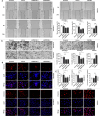The pivotal role of ZNF384: driving the malignant behavior of serous ovarian cancer cells via the LIN28B/UBD axis
- PMID: 39562372
- PMCID: PMC11576860
- DOI: 10.1007/s10565-024-09938-6
The pivotal role of ZNF384: driving the malignant behavior of serous ovarian cancer cells via the LIN28B/UBD axis
Abstract
Zinc finger protein 384 (ZNF384) is a highly conserved transcribed gene associated with the development of multiple tumors, however, its role and mechanism in serous ovarian cancer (SOC) are unknown. We first confirmed that ZNF384 was abnormally highly expressed in SOC tissues by bioinformatics analysis and immunohistochemistry. We further used lentivirus packaging and transfection techniques to construct ZNF384 overexpression or knockdown cell lines, and through a series of cell function experiments, gradually verified that ZNF384 promoted a series of malignant behaviors of SOC cell proliferation, migration, and invasion. By establishing a xenotransplantation model in nude mice, it was confirmed that ZNF384 promoted the progress of SOC in vivo. Mechanistically, Overexpression of ZNF384 enhanced the transcriptional activity of Lin-28 homolog B (LIN28B), which promoted the malignant behavior of SOC cells. In addition, LIN28B could regulate the expression of the downstream factor ubiquitin D (UBD) in SOC cells, further promoting the development of SOC. This study shows that ZNF384 aggravates the malignant behavior of SOC cells through the LIN28B/UBD axis, which may be used as a diagnostic biomarker for patients with SOC.
Keywords: LIN28B; Serous ovarian cancer; UBD; ZNF384.
© 2024. The Author(s).
Conflict of interest statement
Figures








Similar articles
-
Long non-coding RNA HAL suppresses the migration and invasion of serous ovarian cancer by inhibiting EMT signaling pathway.Biosci Rep. 2020 Mar 27;40(3):BSR20194496. doi: 10.1042/BSR20194496. Biosci Rep. 2020. Retraction in: Biosci Rep. 2021 Sep 30;41(9):BSR-20194496_RET. doi: 10.1042/BSR-20194496_RET PMID: 32039453 Free PMC article. Retracted.
-
CircSETDB1 knockdown inhibits the malignant progression of serous ovarian cancer through miR-129-3p-dependent regulation of MAP3K3.J Ovarian Res. 2021 Nov 17;14(1):160. doi: 10.1186/s13048-021-00875-0. J Ovarian Res. 2021. PMID: 34789310 Free PMC article.
-
CST2 promotes cell proliferation and regulates cell cycle by activating Wnt-β-catenin signalling pathway in serous ovarian cancer.J Obstet Gynaecol. 2024 Dec;44(1):2363515. doi: 10.1080/01443615.2024.2363515. Epub 2024 Jun 12. J Obstet Gynaecol. 2024. PMID: 38864487
-
RNF144A suppresses ovarian cancer stem cell properties and tumor progression through regulation of LIN28B degradation via the ubiquitin-proteasome pathway.Cell Biol Toxicol. 2022 Oct;38(5):809-824. doi: 10.1007/s10565-021-09609-w. Epub 2021 May 11. Cell Biol Toxicol. 2022. PMID: 33978933
-
Long noncoding RNA NEAT1, regulated by LIN28B, promotes cell proliferation and migration through sponging miR-506 in high-grade serous ovarian cancer.Cell Death Dis. 2018 Aug 28;9(9):861. doi: 10.1038/s41419-018-0908-z. Cell Death Dis. 2018. PMID: 30154460 Free PMC article.
References
-
- Boehm KM, Aherne EA, Ellenson L, Nikolovski I, Alghamdi M, Vázquez-García I, Zamarin D, Long Roche K, Liu Y, Patel D, et al. Multimodal data integration using machine learning improves risk stratification of high-grade serous ovarian cancer. Nat Cancer. 2022;3:723–33. 10.1038/s43018-022-00388-9. - PMC - PubMed
-
- Chou CL, Chen TJ, Li WS, Lee SW, Yang CC, Tian YF, Lin CY, He HL, Wu HC, Shiue YL, et al. Upregulated ubiquitin D is a favorable prognostic indicator for rectal cancer patients undergoing preoperative concurrent chemoradiotherapy. Onco Targets Ther. 2022;15:1171–81. 10.2147/ott.S378666. - PMC - PubMed
MeSH terms
Substances
LinkOut - more resources
Full Text Sources
Medical
Research Materials

